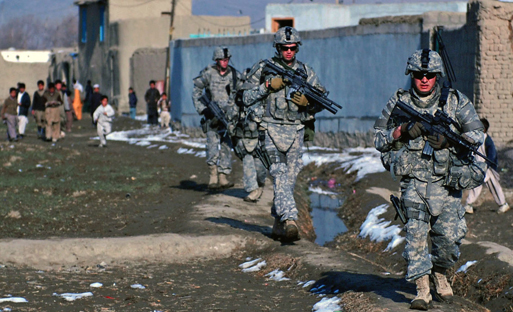 |
 |
Regional Command Capital
Demographics and Terrain
Regional Command Capital (RC Capital) comprises Kabul city and fourteen districts of Kabul province: Bagrami, Chahar Asyab, Deh Sabz, Farza, Guldara, Istalif, Kalakan, Khaki Jabar, Mir Bacha Kot, Mussahi, Paghman, Qarabagh, Shakardara, and Sorubi. With an area of 4,462 square kilometers (1,723 sq. miles), Kabul province is slightly smaller than Delaware. The provincial population is 3,450,000,1 and more than two million live in Kabul city.
Kabul is located in a bowl-like valley surrounded by mountains, such as the Koh-e Paghman and Koh-e Krough to the southwest and the Koh-e Shirdarwaza to the northeast. The mountain passes provide five routes, or “gates” into Kabul. The first route approaches Kabul from the north, forming a part of the Ring Road and connecting Kabul with Mazar-e-Sharif. The second route leads into Kabul from the east along the Kabul River Valley and it connects the capital with the city of Jalalabad. The third route approaches Kabul from the southeast and connects the capital with the southeastern provinces of Logar, Paktiya, and Khost. The fourth route, the Kabul-Kandahar highway, approaches Kabul from the southwest as a part of the Ring Road. The fifth route approaches Kabul from the west, running through the central mountains and intersecting with the Kabul-Kandahar highway just southwest of the capital. The Kabul River rises from the Paghman District and flows east towards Pakistan, providing water for agriculture in Kabul, Laghman and Nangarhar provinces. The Kabul River eventually empties into the Indus River in Pakistan.2 More than half of Kabul province is mountainous or semi mountainous. Kabul province has a dry climate.3
Tajiks and Pashtuns form the majority of the population. Ethnic minorities and Kuchi nomads also live in Kabul province. Dari is predominantly spoken in Kabul city, while Pashto is widely spoken in some districts of Kabul, such as Chahar Asyab, Deh Sabz and Mir Bacha Kot.
Each district has its own administrator and police chief. Haji Din Mohammad, the eldest brother of late famous Jihadi commanders Haji Qadir and Abdul Haq, is the governor of the province. Engineer Mir Abdul Ahad Sahebi is the mayor of Kabul, and General Mohammad Ayub Salangi serves as the chief of police in the province.
Security
Security situation has deteriorated in the Kabul region over the past two years. Enemy groups now control parts of Kabul’s neighboring provinces, such as Logar and Wardak. These groups also carried out several high-level armed and suicide attacks in Kabul in 2008 and early 2009.
Suicide attackers stormed Kabul's most famous luxury hotel on 14 January, 2008, killing seven people.4 President Hamid Karzai narrowly escaped the fourth attempt on his life on April 27, 2008, after fighters attacked an Independence Day ceremony in Kabul.5 A suicide bombing targeting the Indian embassy in Kabul on July 7, 2008, killed at least 41 people and injured 141.6 On February 11, 2009, suicide bombers and gunmen launched simultaneous attacks on three government sites in Kabul city, including the Ministry of Justice, killing at least twenty and wounding over 50 people.7
Organized enemy groups, however, are not the only security threat. Many crimes such as kidnappings, armed robberies, and killings have increasingly become prevalent in Kabul.
Economic Development
Income per capita and living conditions are comparatively better in Kabul than any other province. An average of 61% of Kabul residents have access to electricity – 71% in urban areas, while only 29% in rural places.8
ISAF
France is the lead nation in RC Capital, which is under the command of Brigadier General M. Stollsteiner. Responsibility for security in RC Capital was transferred to the Afghan National Security Forces on August 28, 2008; however, this move was principally symbolic and International Security Assistance Force (ISAF) remain in Kabul.9
The headquarters of ISAF is located in Kabul and serves as NATO’s operational central command.10 The ISAF headquarters commands the five Regional Commands and works with the government of Afghanistan, the United Nations Assistance Mission in Afghanistan (UNAMA), and other international and non-governmental organizations in implementing military and reconstruction efforts.11 The ISAF headquarter is separate from the RC Capital headquarters in Kabul. Over 1,700 multinational forces are stationed in the ISAF headquarters in Kabul.12 A total of 5,740 troops are present in the RC Capital.13 Kabul International Airport (KAIA) serves as the Forward Support Base (FSB) for the Kabul region. Hungary has responsibility for the FSB.14 KAIA is the primary airport in the country for both commercial and military flights.15
----------------------------------------------------------
Endnotes
1 United States Agency for International Development (USAID), "Afghanistan's Provinces," USAID: Afghanistan.
2 Alexander Keith Johnston, “Afghanistan,” in Physical, Historical, Political, & Descriptive Geography, London, 1985, 339.
3 Regional Rural Economic Regeneration Strategies (RRERS), “Provincial Profile, Kabul,” October 10, 2007.
4 Declan Walsh, “Seven killed as Taliban militants storm luxury hotel in Kabul,” The Guardian, January 15, 2008.
5 Carlotta Gall and Abdul Waheed Wafa, “Karzai Escapes Attack in Kabul by Gunmen,” The New York Times, April 28, 2008.
6 “Bomb Rocks India Embassy in Kabul,” BBC News, July 7, 2008.
7 Richard A. Oppel, Abdul Waheed Wafa and Sangar Rahimi, “20 Dead as Taliban Attackers Storm Kabul Offices,” The New York Times, February 11, 2009.
8 Ministry of Rural Rehabilitation and Development (MRRD) of Afghanistan, “Provincial Profile – Kabul.”
9 “NATO hands Kabul security to Afghan forces,” Reuters, August 28, 2008.
10 North Atlantic Treaty Organization, "ISAF Headquarters," December 19, 2007.
11 North Atlantic Treaty Organization, "International Security Assistance Force and Afghan National Army Strength & Laydown," April 3, 2009.
12 North Atlantic Treaty Organization, "ISAF Headquarters," December 19, 2007.
13 North Atlantic Treaty Organization, "International Security Assistance Force and Afghan National Army Strength & Laydown," April 3, 2009.
14 North Atlantic Treaty Organization, "ISAF Regional Command Structure," January 14, 2009.
15 North Atlantic Treaty Organization, "ISAF Headquarters," December 19, 2007.
Tags

